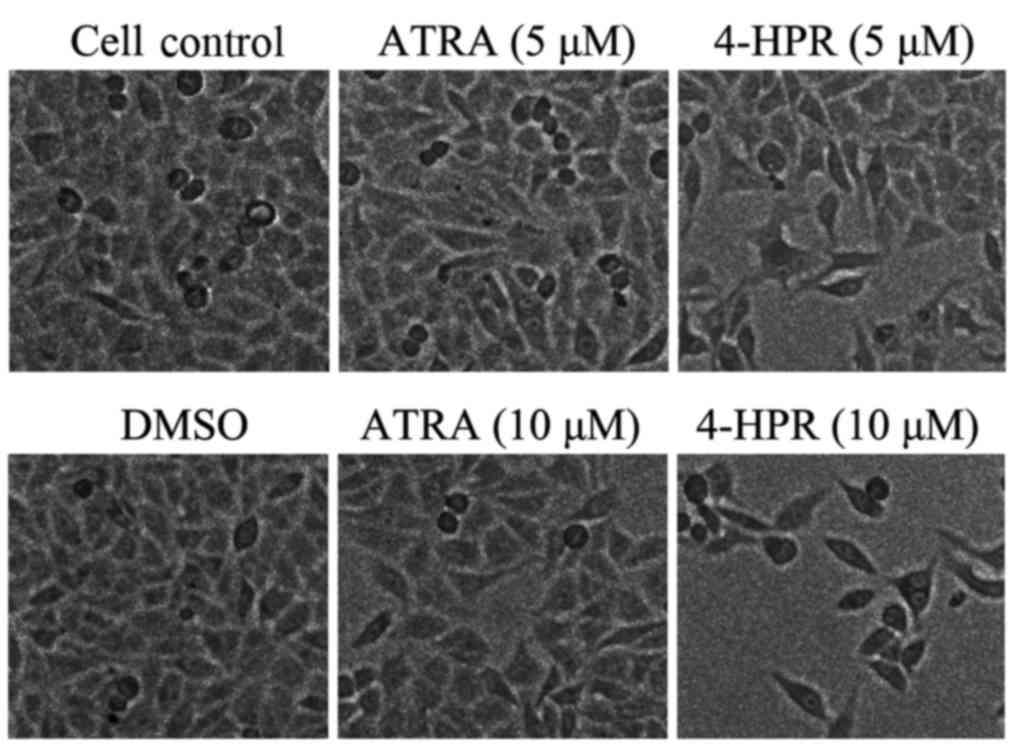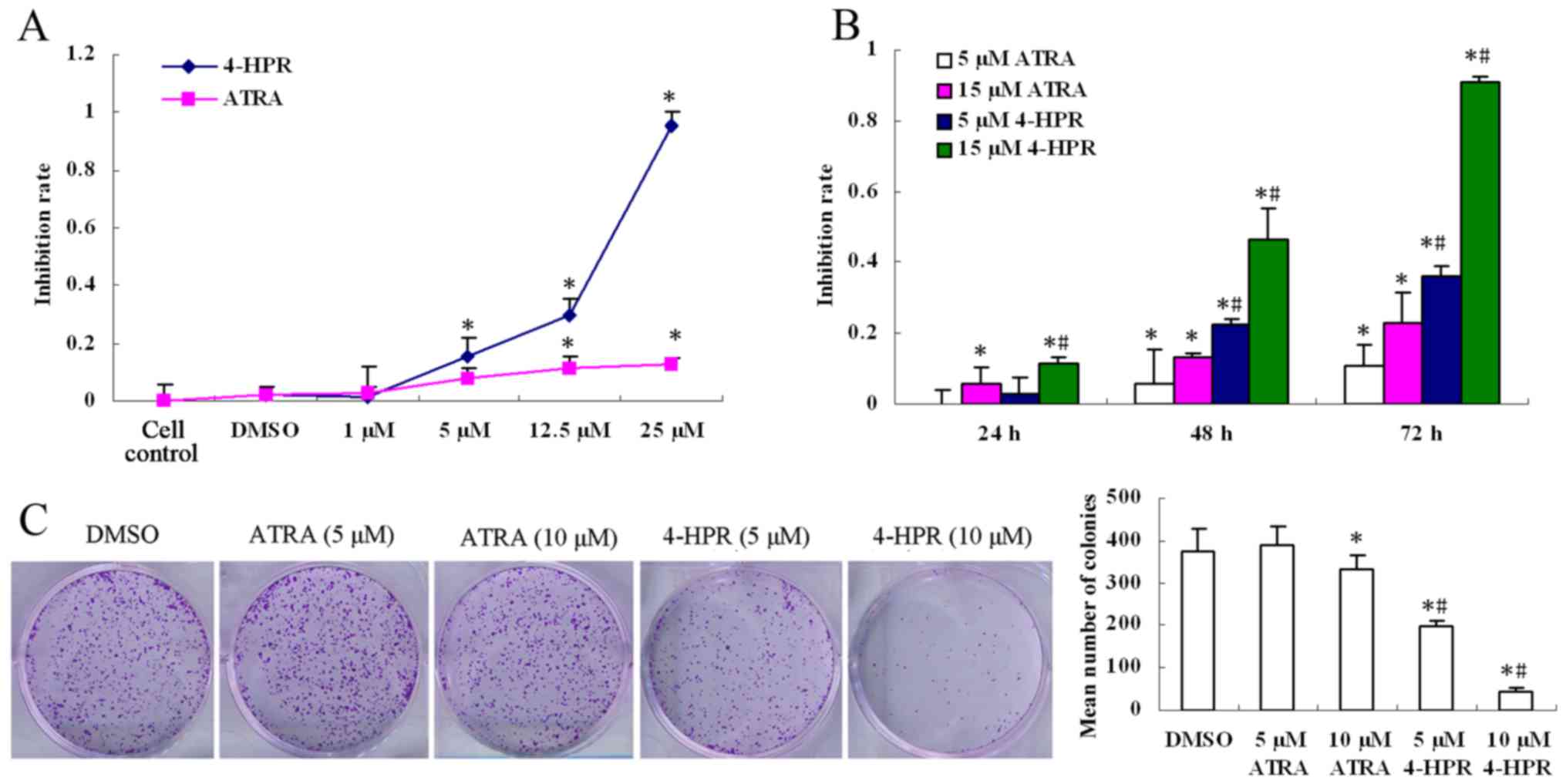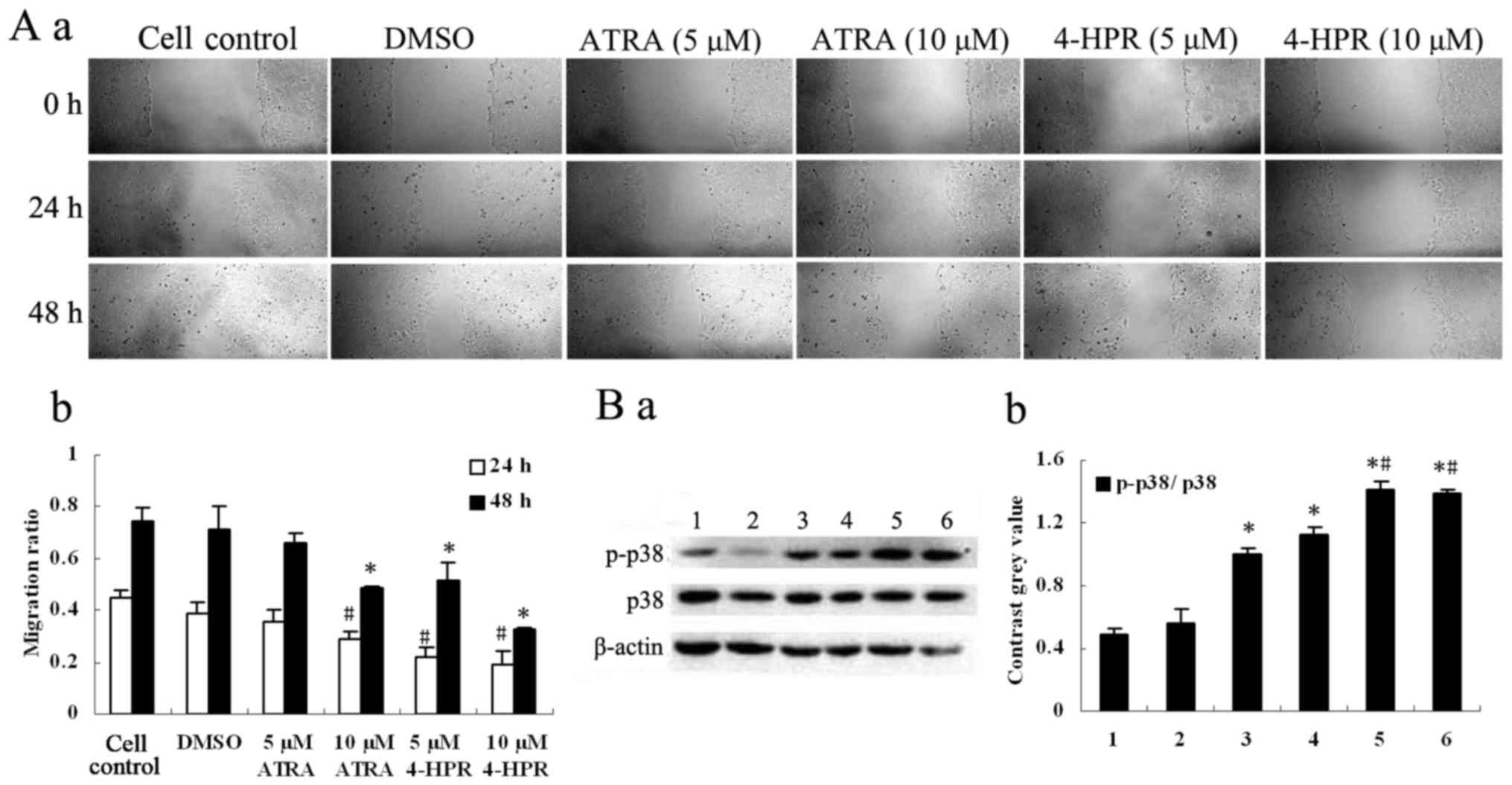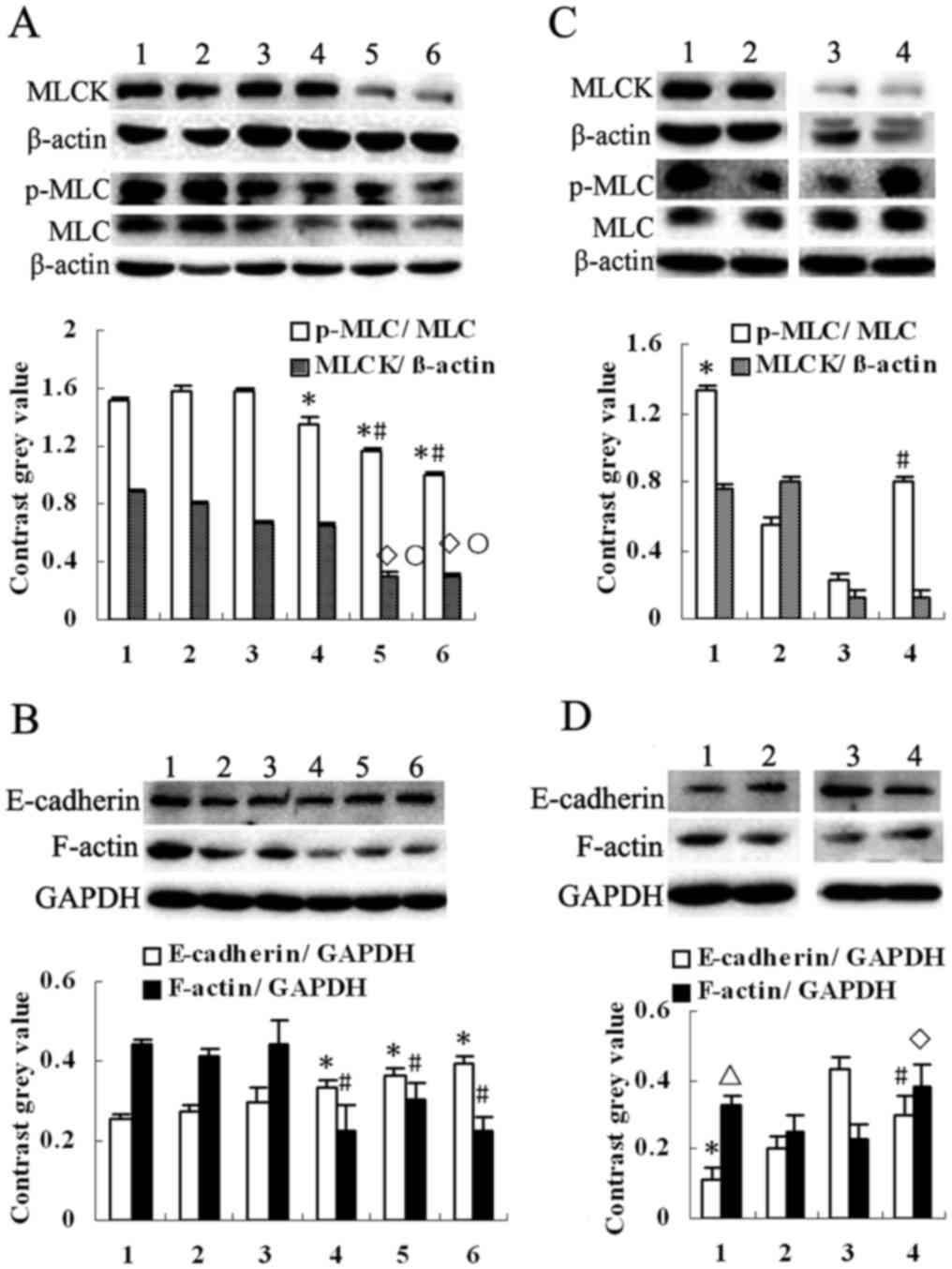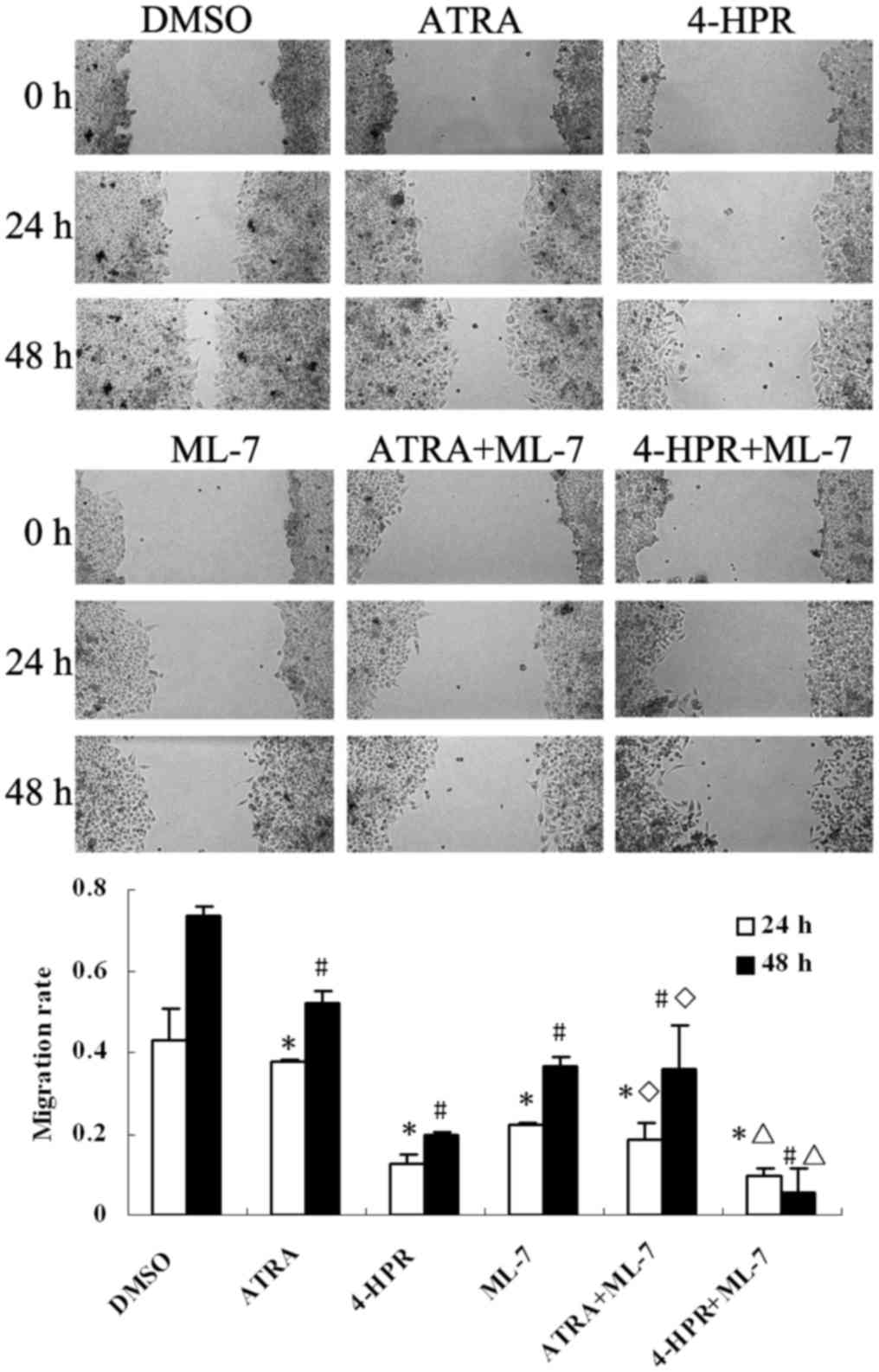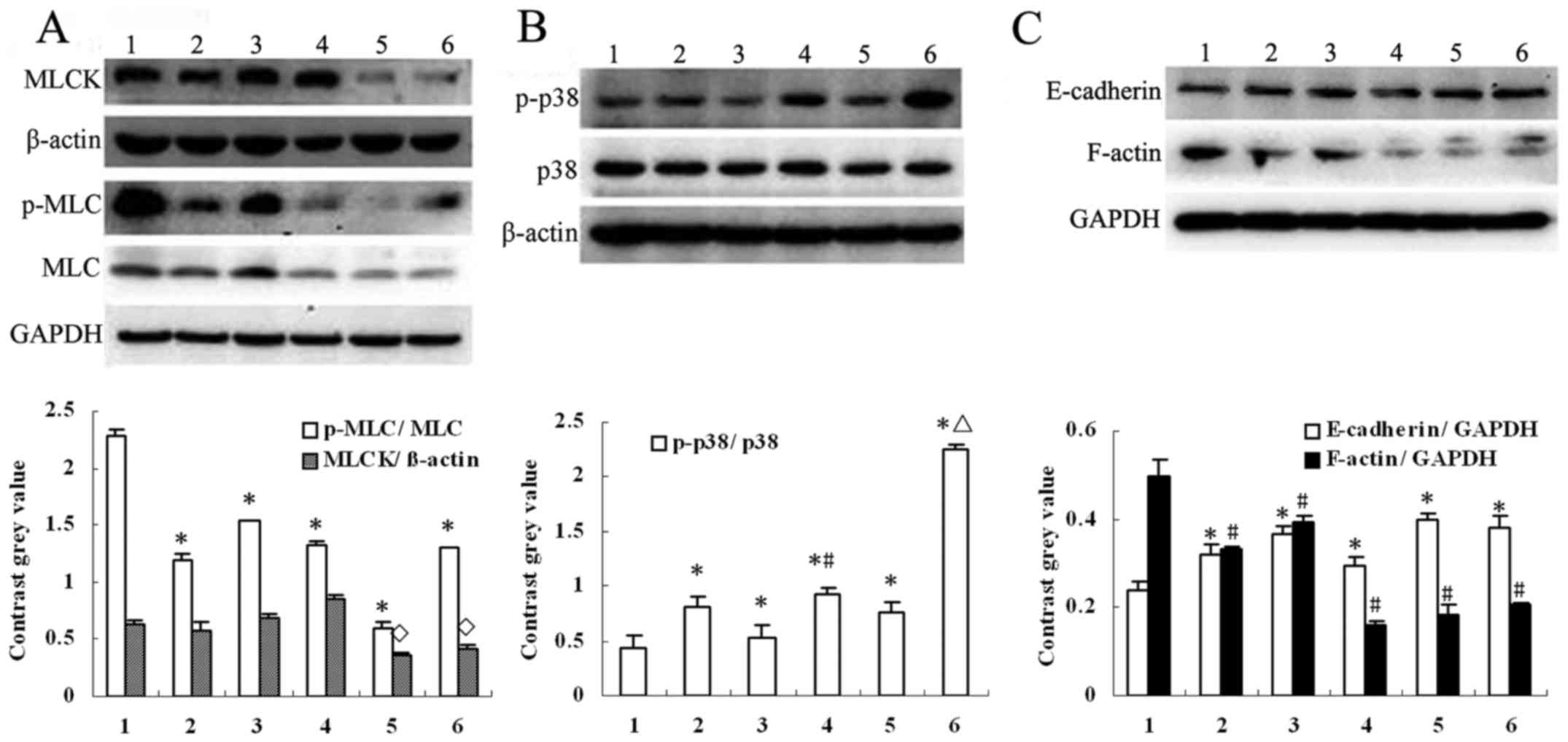Fenretinide inhibits the proliferation and migration of human liver cancer HepG2 cells by downregulating the activation of myosin light chain kinase through the p38‑MAPK signaling pathway
- Authors:
- Published online on: May 16, 2018 https://doi.org/10.3892/or.2018.6436
- Pages: 518-526
Abstract
Introduction
Human liver cancer, hepatoblastoma, is the most common malignant liver tumor in pediatrics (1). Although surgical excision of the tumor mass can be performed, challenges still remain for patients with vascular invasion and metastatic disease (2). Inhibition of metastasis is hence a key strategy for liver cancer treatment, and the discovery of potential inhibitors of metastasis could lead to improvements in therapy. Optional therapeutic schemes and auxiliary substances have been widely explored; however, only few are effective (3). Thus, the development of new drugs is required for optimal treatment with fewer complications.
All-trans retinoic acid (ATRA) has been effectively used for inducing the differentiation of acute promyelocytic leukemia cells (4); however, it does not cure patients with liver cancer, as liver cancer requires nearly a 10 times higher concentration than leukemic cells (5). Such high concentrations are not suitable for clinical use due to several side effects, including retinoic acid syndrome, skin dryness, and liver damage. N-(4-hydroxyphenyl)retinamide (4-HPR or fenretinide), an artificial variant of ATRA, exhibits markedly different effects to ATRA. Presently, 4-HPR is considered to be a drug with fewer side effects (6). Vaccari et al found that 4-HPR influences cell matrix interactions and blocks tumor progression to locally invasive malignacy (7). 4-HPR was found to reduce the incidence of breast cancer when used as a chemoprevention agent (8) and prevented secondary breast cancer in a phase III trial (9). Furthermore, 6 years later Kang et al demonstrated that 4-HPR inhibited the invasion of breast cancer cells (10). Similarly, Benelli et al demonstrated that 4-HPR hindered the migration and invasion of prostate cancer cells (11), and it has now entered clinical phase II trials (12). In the present study, we compared the antiproliferative effects of 4-HPR with ATRA on HepG2 cells, and explored the functions and mechanisms of 4-HPR in modulating their migration capacity.
Mitogen-activated protein kinases (MAPKs) are highly conserved signaling pathway proteins, playing vital roles in deciding cell fate (13,14). p38-MAPK is activated by different stimuli, including chemical agents, cytokines and oxidative stress (13–15). Sustained activation of p38-MAPK induces cell death (14,16). 4-HPR-induced sustained activation of p38-MAPK, accompanied by cell apoptosis, has been reported in several types of tumors, including neuroblastoma, HeLa, T-cell leukemia/lymphoma cells (17–19); however, HepG2 cells were reported to be resistant to the apoptotic effect of 4-HPR (20). Whether 4-HPR influences the p38-MAPK pathway in HepG2 cells remains unclear.
Myosin light chain kinase (MLCK) is a crucial Ca2+/calmodulin-dependent effector, and controls the migration of smooth- and non-muscle cells through the phosphorylation of Ser19 and Thr18 on myosin light chains (MLC) (21). Previous studies have reported that both MLCK and activated myosin II are abundant in the lamellar protrusive structures of certain cell types during migration (22,23). Several studies have revealed p38-MAPK pathway links in the tumor cells treated with 4-HPR, and also some researches have found that MLCK is involved in the migration of tumor cells; however, the underlying mechanism that explains how these factors influence liver cancer is still unknown.
Therefore, we hypothesized that 4-HPR inhibits the proliferation and migration of liver cancer cells via MLCK and p38-MAPK signaling. This study was aimed to provide an experimental basis for the further application of 4-HPR in liver cancer therapy.
Materials and methods
Cell lines and major reagents
The human liver cancer cell line HepG2 (24) was obtained from the American Type Culture Collection (ATCC; Manassas, VA, USA). HyClone Dulbecco's modified Eagle's medium (DMEM; low glucose) was purchased from GE Healthcare Life Sciences (Logan, UT, USA). Fetal bovine serum (FBS) was purchased from Tianhang Biological Technology (Hanzhou, Zhejiang, China). Primary antibodies: Rabbit antihuman monoclonal MLCK (cat. no. ab92721) and E-cadherin (cat. no. ab40772), mouse anti-human monoclonal F-actin (cat. no. ab205) were obtained from Abcam (Cambridge, MA, USA); rabbit anti-human monoclonal phosphpho-p38 MAPK (cat. no. 4511), mouse anti-human monoclonal phospho-MLC (cat. no. 3675) were purchased from Cell Signaling Technology (Danvers, MA, USA); rabbit anti-human polyclonal MLC (cat. no. 15354-1-AP), mouse anti-human monoclonal GAPDH (cat. no. 60004-1-Ig) were obtained from Proteintech Group (Wuhan, Hubei, China); rabbit anti-human polyclonal p38 MAPK (cat. no. sc-7149) and mouse antihuman monoclonal β-actin (cat. no. sc-47778) were obtained from Santa Cruz Biotechnology (Santa Cruz, CA, USA). All secondary antibodies (cat. nos. AP124P and AP132P) were obtained from Millipore (Billerica, MA, USA). Western blot primary antibody diluent was obtained from Beyotime Institute of Biotechnology (Beijing, China). Enhanced chemiluminescence reagent Plus (ECL) reagents were purchased from Thermo Fisher Scientific (Waltham, MA, USA). 4-HPR was obtained from MedChem Express (Deer Park, NY, USA). ATRA and ML-7 was purchased from DC Chemicals (Shanghai, China). SB203580 was obtained from Selleck Chemicals (Houston, TX, USA). 4-HPR, ATRA, ML-7 and SB203580 were dissolved in a small amount of dimethyl sulfoxide (DMSO) before addition to the complete cell culture medium. MTS was purchased from Promega (Madison, WI, USA).
Cell culture and morphologic observation after drug treatment
Cells were seeded in 6-well plates, and cultured in DMEM supplemented with 10% FBS, penicillin (100 U/ml) and streptomycin (100 µg/ml). The plates were incubated at 37°C with 5% CO2 in a humidified atmosphere. When the cell density reached 40–50% confluency, the cells were treated with 4-HPR or ATRA at 5 or 10 µM or with DMSO alone for 48 h. Cell morphology was imaged using a microscope (Leica DMI3000B; Leica Microsystems, Wetzlar, Germany).
Cell viability assay
Cells (5×103 cells/well) were plated in 96-well plates, and then treated with 4-HPR or ATRA (5 or 15 µM) at different time intervals (24–72 h), or persistently treated with a dose range of 1–25 µM of 4-HPR or ATRA for 48 h at 37°C. Following treatment, MTS (20 µl/well) was added to each well and incubated for 1 h at 37°C. Optical density (OD) values were measured at 490 nm using a Microplate reader (ELX800; BioTek, Winooski, VT, USA) at 37°C. Cell inhibition rate=(OD490 of the cell control group-OD490 of the experimental group)/OD490 of the cell control group.
Plate colony formation assay
When the cells were in logarithmic growth, they were plated in 6-well plates. After culturing overnight, the cells were treated with 4-HPR or ATRA (5 or 10 µM) for 48 h, and were then collected as single cell suspensions. Approximately, 2,000 cells/wells were plated into a fresh 6-well plate, and the plate was incubated for approximately 10 days. When the colonies were clearly visible with the naked eye, the medium was discarded and the cells were washed twice with phosphate-buffered saline (PBS), fixed with 4% paraformaldehyde, and then stained with 1% crystal violet. In five random visual fields, the colonies containing ≥50 cells were counted by an inverted microscope (Leica DMI3000B; Leica Microsystems) for each well.
Wound healing assay
The migratory ability of the HepG2 cells was determined by the wound healing assay. Cells were seeded in 12-well plates. When the growth reached 95% confluency, the cell monolayer was scratched with a sterilized 200-µl pipette tip, and then the cells were washed thrice with PBS. Furthermore, two concentrations (5 and 10 µM) of 4-HPR or ATRA were added to the cell culture medium. The migration rate of cells was determined by observation under a microscope at different time intervals (0, 24, and 48 h). The nick distance of the wound was measured by Image-Pro Plus software 6.0 (Media Cybernetics, Inc., Rockville, MD, USA).
Western blot analysis
Cells were treated with 4-HPR or ATRA (5 or 10 µM) for 48 h. Total cellular proteins were extracted with lysis buffer (Tris-HCl, pH 7.14, 150 mM NaCl, 1 mM EDTA, 1% Triton X-100, 0.1% SDS, 1 mM leupeptin and 1 mM PMSF) on ice for 30 min. All the samples were mixed with loading buffer, and then boiled for 5 min. The proteins were separated by 8–12% sodium dodecyl sulfate-polyacrylamide gel electrophoresis (SDS-PAGE). Furthermore, the proteins were transferred to polyvinylidene difluoride (PVDF) membranes, and blocked with 5% nonfat dry milk in Tris-buffered saline Tween-20 (TBST) buffer (20 mM Tris-HCl, pH 7.6, 150 mM NaCl, and 0.05% Tween-20) for 2 h at room temperature. The membranes were then incubated in WB primary antibody diluent with the indicated primary antibodies: MLCK (1:8,000), phospho-MLC (1:1,000), MLC (1:1,000), phospho-p38 (1:1,000), p38 (1:1,000), F-actin (1:500), E-cadherin (1:4,000), GAPDH (1:50,000), β-actin (1:1,000), respectively overnight at 4°C. Thereafter, the membranes were incubated with the corresponding horseradish peroxidase (HRP)-conjugated secondary antibodies (diluted with TBST containing 5% non-fat dry milk) for 2 h at room temperature, and detected by chemiluminescence using an ECL kit. Specific complexes were revealed by enhanced chemiluminescence (Clinx Science Instruments, Shanghai, China). The image data were quantified using Quantity One software 4.6.2 (Bio-Rad Laboratories, Inc., Hercules, CA, USA).
HepG2 cell treatment with p38-MAPK and MLCK inhibitors
The pharmacological inhibitors of the p38-MAPK signaling pathway (SB203580, 25 µM) and MLCK (ML-7, 20 µM) were used in combination with 4-HPR or ATRA (10 µM) to investigate the role of p38-MAPK and MLCK in 4-HPR/ATRA-induced inhibition of HepG2 cell migration. Thereafter, wound healing assay and western blot analysis were used to measure the migration distances and protein levels in the cells.
Statistical analysis
Results are expressed as means ± standard deviation (SD). The data were assessed by one-way ANOVA using SPSS 10.0 software (SPSS, Inc., Chicago, IL, USA). P-values <0.05 were considered as statistically significant.
Results
4-HPR alters the morphology of HepG2 cells
In a previous study, Yang et al (20) found that HepG2 cells were resistant to the apoptotic effect of 4-HPR after 24 h treatment; however, 4-amino-2-trifluoromethyl-phenyl retinate (ATPR), another ATRA derivative, has been observed to inhibit HepG2 cell proliferation after 48 h of culture in our laboratory (25). Based on this report, we chose two concentrations of 4-HPR (5 and 10 µM) to treat HepG2 cells for 48 h. Changes in the cell morphology and any inhibitory effects were examined by microscopy. The cells congregated neatly and closely in the solvent (DMSO) control (Fig. 1); however, after treatment with a low concentration of 4-HPR, the cell density and cell-to-cell contact was reduced. In the high concentration group, cell density was remarkably reduced, and the cell morphology was altered into a slender shape containing more filopodia when compared with the vehicle control (Fig. 1). These changes could be associated with cell migration after 4-HPR treatment. Cell density was reduced only slightly in the high concentration ATRA group, and was not accompanied by any noticeable change in the cell morphology.
4-HPR inhibits the proliferation of HepG2 cells
A cell viability assay was used to probe the effects of 4-HPR and ATRA on the proliferation of HepG2 cells. Cell viability was distinctly inhibited in a dose- and time-dependent manner by 4-HPR (Fig. 2A and B). At the same concentration, the inhibitory effect of 4-HPR was more intense than that of ATRA (P<0.05). In addition, there was no obvious difference between the cell control and the DMSO control group. Based on the aforementioned data, the DMSO control, and an incubation time of 48 h were chosen for further studies. A plate colony formation assay was used to assess the colonizing ability of HepG2 cells in vitro. After 10 days of culture, the density and size of the colonies were both reduced in a dose-dependent manner by 4-HPR (P<0.05); however, they were only changed slightly at the high concerntration of ATRA compared with the control group (P<0.05). The mean numbers of colonies in the 4-HPR group were lower than those in the ATRA group (P<0.05), which was consistent with the morphological change and cell viability analyses (Fig. 2C).
4-HPR hinders the migration of HepG2 cells
We investigated the effect of 4-HPR and ATRA on the migration of HepG2 cells using a wound healing assay. 4-HPR inhibited the migration of HepG2 cells (Fig. 3A) in a dose-dependent manner (P<0.05, compared with the control), consistent with the data from the cell proliferation assay. 4-HPR inhibited cell migration at two concentrations of 5 and 10 µM (P<0.05, compared with the control), whereas ATRA only produced inhibition at 10 µM (P<0.05, compared with the control).
4-HPR increases the activation of p38-MAPK in HepG2 cells
Treatment of cells with 4-HPR increased the phosphorylation of p38 (p-p38) in a dose-dependent manner, and the expression of p38 was also increased in the high concentration group, as revealed by Western blot analysis (P<0.05, compared with the control). ATRA also slightly increased the phosphorylation of p38 (p-p38) (P<0.05, compared with the control); however, the increased levels elicited by 4-HPR were much higher than those produced by ATRA (P<0.05) (Fig. 3B). These results indicated that 4-HPR may inhibit the migration of HepG2 cells through the p38-MAPK signaling pathway.
p38-MAPK inhibitor reverses the inhibitory effect of 4-HPR on HepG2 cell migration
To determine whether 4-HPR inhibits HepG2 cell migration via p38-MAPK signaling, the cells were pretreated with the p38-MAPK inhibitor SB203580 for 1 h, and then exposed to 4-HPR (10 µM) for 48 h. 4-HPR-induced inhibition of migration was abrogated by the presence of the SB203580 at both 24 and 48 h (P<0.05, compared with 4-HPR alone) (Fig. 4). These data indicate that 4-HPR stimulates p38 activity leading to migration inhibition in the liver cancer cells.
4-HPR decreases the expression of MLCK and phosphorylation of MLC in HepG2 cells, and a p38-MAPK inhibitor had an inverse effect
Since myosin light-chain kinase (MLCK) plays a crucial role in cell migration and metastasis, we investigated the expression of this protein, as well as its substrate (MLC) and product (p-MLC). This revealed that 4-HPR markedly reduced the expression of MLCK and the phosphorylation of MLC (p-MLC), and also decreased the expression of MLC (P<0.05, compared with the control) (Fig. 5A). Concomitantly, 4-HPR inhibited the expression of F-actin and increased the expression of E-cadherin (P<0.05, compared with the control) (Fig. 5B). ATRA reduced the expression of p-MLC (P<0.05, compared with the control); however, it caused no obvious change in the MLCK levels. 4-HPR reduced the expression of MLCK and the phosphorylation of MLC to a much greater extent than ATRA (P<0.05). However, when the cells were pretreated with SB203580, p-MLC and F-actin were upregulated and E-cadherin was downregulated when compared to 4-HPR or ATRA treatment alone (P<0.05) (Fig. 5C and D). These observations fit well with the wound healing assay data presented above.
Reduction of MLCK activation inhibits the migration of HepG2 cells
To verify the association between HepG2 migration and the MLCK signaling pathway, a wound healing assay was performed using ML-7 (a specific inhibitor of MLCK) in the culture medium. After treatment with ML-7 for 24 or 48 h, the migration rate of HepG2 cells was suppressed when compared with the control (P<0.05) (Fig. 6). Moreover, the group treated with both 4-HPR and ATRA combined with ML-7 exhibited greater inhibition rates than the group treated with 4-HPR or ATRA alone (P<0.05) (Fig. 6).
ML-7 increases the phosphorylation of p38 and inhibits the activation of MLCK in HepG2 cells
The underlying mechanism, that is, the nature of the signaling pathway tied to MLCK repression and p38-MAPK activation after 4-HPR treatment, remained unclear. Therefore, we investigated the protein expression after ML-7 treatment (Fig. 7A-C). ML-7 not only inhibited the activity of MLCK by reducing the expression of p-MLC, but also activated p38-MAPK by enhancing the expression of p-p38 in HepG2 cells (P<0.05, compared with the control). ML-7 also altered the expression of F-actin and E-cadherin, and ML-7 combined with 4-HPR or ATRA further increased the levels of p-p38 compared to 4-HPR or ATRA alone (P<0.05).
Discussion
Patients with liver cancer often have unfavorable prognoses and short lifespans due to early metastasis (26). The process of metastasis involves tumor cell escape, migration, invasion of the basement membrane, and growth at new locations (27). Knowledge concerning the circumstances that favor liver cancer cell metastasis will aid in finding treatment options that can control the growth and metastasis of liver cancer.
4-HPR is a known retinoid analog that is active against several types of tumors that arise via different ontological mechanisms (28). A phase II clinical study in adults with prostate cancer revealed good compatibility with 4-HPR (29), and similar results were obtained in a neuroblastoma in a phase I study in children (30). Antitumor activity of 4-HPR was also observed in medulloblastoma (31), human pancreatic cancer (32), chronic myeloid leukemia (33), and in a lung cancer xenograft mouse model (34). Moreover, Sogno et al reported that 4-HPR is effective in inhibiting angiogenesis (35).
In our study, we compared the effect of 4-HPR with ATRA. 4-HPR potently inhibited the growth of and colony formation of HepG2 cells, and suppressed cell migration. Compared with ATRA, the inhibitory effect of 4-HPR on cell growth and colony formation was achieved at a lower concentration (5 µM). We observed that the IC50 of HepG2 cells was approximate 12.5 µM in the cell viability assay. Notably, pediatric neuroblastoma patients who received oral doses of 4-HPR achieved a blood serum concentration of 12.9 µM (30). Thus, the effective concentrations of 4-HPR in HepG2 cells implies that 4-HPR may be a candidate for liver cancer therapy. When HepG2 cells were treated with 4-HPR for only 24 h, a significantly slower migration of the cells was observed; however, no effect could be detected using ATRA for the same amount of time. ATRA required much higher concentrations and longer incubation times to achieve the same inhibition rates as 4-HPR. These results indicate that much lower amounts of 4-HPR are required for growth suppression and migration of liver cancer cells, and hence, the drug may be applied clinically with less toxicity.
The main antitumor activity of 4-HPR is the induction of apoptosis by retinoic acid receptor-dependent or -independent mechanisms (8,36). 4-HPR also reduces the plasma concentrations of retinol and retinol binding protein (37). To determine whether the cytotoxic effect of 4-HPR in HepG2 cells is due to the induction of apoptosis, we analyzed the expression levels of proteins involved in this process; however, we found no marked changes in such proteins upon 4-HPR treatment (data not shown). A previous report is consistent with our results (20); hence, the mechanism of 4-HPR action might be different in HepG2 cells. The p38-MAPK pathway has been reported to mediate various cellular behaviors that are closely related to tumor initiation and progression (38). Nevertheless, the regulation of p38-MAPK in tumor development is complicated and controversial, involving responses of various cells and cancer types (39). In this study, we found that 4-HPR inhibited the migration of HepG2 cells by significantly inducing the activation of p38-MAPK. When the p38-MAPK inhibitor SB203580 was added to the culture system preceding 4-HPR treatment, the inhibitory effect on migration was ameliorated. This allows for the preliminarily conclusion that 4-HPR inhibits the migration of HepG2 cells via stimulation of the p38-MAPK pathway.
MLCK confers the rat pituitary adenoma cells with a slow and directional motility (40), and phosphorylation of MLC markedly improves the invasion and migration ability of gastric cancer cells (41). Leiomyosarcoma patients with high expression of MLCK or p-MLC have shorter life spans than the patients with low expression of these proteins (42). In our study, treatment of HepG2 cells with 4-HPR for 48 h resulted in the downregulated expression of MLCK. Simultaneously, the expression of MLCK and p-MLC were significantly suppressed. When the activation of MLCK was inhibited by ML-7, cell migration was retarded and accompanied by reduced p-MLC levels. In addition, ML-7 in combination with 4-HPR or ATRA enhanced the inhibitory effect on the migration of HepG2 cells, compared to 4-HPR or ATRA alone. E-cadherin and F-actin play important roles in tumor cell migration (43,44). E-cadherin protein levels often decrease and F-actin levels increase in aggressive tumor cells (45,46). 4-HPR downregulated the expression of F-actin and upregulated the expression of E-cadherin in HepG2 cells.
Based on our results, 4-HPR decreased the proliferation and migration of HepG2 cells in association with activation of p38-MAPK and inhibition of MLCK. We measured the protein expression of MLCK and p-MLC after SB203580 pretreatment and found that p-MLC increased compared to 4-HPR treatment alone. Meanwhile, in cells treated with ML-7 and 4-HPR, p-p38 was upregulated compared to treatment with 4-HPR alone. These results provide evidence of a reciprocal cross-talk between MLCK and p38-MAPK.
Erk-MAPK governs the cell movement via p-MLC (47). We also found an altered expression of p-p38 preceded that of p-MLC after 4-HPR treatment (data not shown). Thus, we presently believe that 4-HPR generates its effects on HepG2 cells via inhibiting MLCK activation through the p38-MAPK signaling pathway. The exact mechanism of HepG2 cell migration involving p38-MAPK via p-MLC, however, needs to be further investigated.
Collectively, the present study using the HepG2 cell line demonstrated a marked potential effects of 4-HPR on liver cancer. 4-HPR potentially inhibits the biological behaviors involved in liver cancer metastasis, and may be an alternative therapeutic agent for its prevention. Despite these findings, further studies on the specific targets of 4-HPR in these signaling pathways are required, as well as therapeutic experiments using in vivo models are warranted.
Acknowledgements
The authors thank Pro Zhilin Qi (Department of Biochemistry, Wannan Medical College, Wuhu, China) for her technical support.
Funding
The present study was financially supported by the National Natural Science Foundation of China (nos. 81272399 and 81400695), the Natural Science Foundation of Anhui Province (no. 1508085QH185) and the Youth Projects of Wannan Medical College (no. WK201403).
Availability of data and materials
The datasets used during the present study are available from the corresponding author upon reasonable request.
Authors' contributions
YW, WW and LZ conceived and designed the study. LZ performed the experiments. HL provided the cell line. QZ and HL gave experimental guidance. LZ and DH analyzed the experimental data and wrote the paper. YW reviewed and edited the manuscript. All authors read and approved the manuscript and agree to be accountable for all aspects of the research in ensuring that the accuracy or integrity of any part of the work are appropriately investigated and resolved.
Ethics approval and consent to participate
All experimental protocols were approved by the Institutional Review Board of Anhui Medical University (Hefei, China).
Consent for publication
Not applicable.
Competing interests
The authors declare that they have no competing interests.
References
|
Allan BJ, Parikh PP, Diaz S, Perez EA, Neville HL and Sola JE: Predictors of survival and incidence of hepatoblastoma in the paediatric population. HPB (Oxford). 15:741–746. 2013. View Article : Google Scholar : PubMed/NCBI | |
|
McAteer JP, Goldin AB, Healey PJ and Gow KW: Surgical treatment of primary liver tumors in children: Outcomes analysis of resection and transplantation in the SEER database. Pediatr Transplant. 17:744–750. 2013. View Article : Google Scholar : PubMed/NCBI | |
|
Kremer N, Walther AE and Tiao GM: Management of hepatoblastoma: An update. Curr Opin Pediatr. 26:362–369. 2014. View Article : Google Scholar : PubMed/NCBI | |
|
Wu X, Wang X, Qien X, Liu H, Ying J, Yang Z and Yao H: Four years' experience with the treatment of all-trans retinoic acid in acute promyelocytic leukemia. Am J Hematol. 43:183–189. 1993. View Article : Google Scholar : PubMed/NCBI | |
|
Wu X, Lu H, Zhou L, Huang Y and Chen H: Changes of phosphatidylcholine-specific phospholipase C in hepatocarcinogenesis and in the proliferation and differentiation of rat liver cancer cells. Cell Biol Int. 21:375–381. 1997. View Article : Google Scholar : PubMed/NCBI | |
|
Cooper JP, Reynolds CP, Cho H and Kang MH: Clinical development of fenretinide as an antineoplastic drug: Pharmacology perspectives. Exp Biol Med (Maywood). 242:1178–1184. 2017. View Article : Google Scholar : PubMed/NCBI | |
|
Vaccari M, Silingardi P, Argnani A, Horn W, Giungi M, Mascolo MG, Grilli S and Colacci A: In vitro effects of fenretinide on cell-matrix interactions. Anticancer Res. 20:3059–3066. 2000.PubMed/NCBI | |
|
Aoyama Y: Experimental studies on the effects of the combined use of N-(4-hydroxyphenyl)retinamide (4-HPR) and tamoxifen (TAM) for estrogen receptor (ER)-negative breast cancer. Kurume Med J. 49:27–33. 2002. View Article : Google Scholar : PubMed/NCBI | |
|
Veronesi U, Mariani L, Decensi A, Formelli F, Camerini T, Miceli R, Di Mauro MG, Costa A, Marubini E, Sporn MB and De Palo G: Fifteen-year results of a randomized phase III trial of fenretinide to prevent second breast cancer. Ann Oncol. 17:1065–1071. 2006. View Article : Google Scholar : PubMed/NCBI | |
|
Kang H, Lee M, Choi KC, Shin DM, Ko J and Jang SW: N-(4-hydroxyphenyl)retinamide inhibits breast cancer cell invasion through suppressing NF-κB activation and inhibiting matrix metalloproteinase-9 expression. J Cell Biochem. 113:2845–2855. 2012. View Article : Google Scholar : PubMed/NCBI | |
|
Benelli R, Monteghirfo S, Venè R, Tosetti F and Ferrari N: The chemopreventive retinoid 4HPR impairs prostate cancer cell migration and invasion by interfering with FAK/AKT/GSK3beta pathway and beta-catenin stability. Mol Cancer. 9:1422010. View Article : Google Scholar : PubMed/NCBI | |
|
Moore MM, Stockler M, Lim R, Mok TSK, Millward M and Boyer MJ: A phase II study of fenretinide in patients with hormone refractory prostate cancer: A trial of the Cancer Therapeutics Research Group. Cancer Chemother Pharmacol. 66:845–850. 2010. View Article : Google Scholar : PubMed/NCBI | |
|
Kyriakis JM and Avruch J: Mammalian mitogen-activated protein kinase signal transduction pathways activated by stress and inflammation. Physiol Rev. 81:807–869. 2001. View Article : Google Scholar : PubMed/NCBI | |
|
Matsuzawa A, Nishitoh H, Tobiume K, Takeda K and Ichijo H: Physiological roles of ASK1-mediated signal transduction in oxidative stress- and endoplasmic reticulum stress-induced apoptosis: Advanced findings from ASK1 knockout mice. Antioxid Redox Signal. 4:415–425. 2002. View Article : Google Scholar : PubMed/NCBI | |
|
Martindale JL and Holbrook NJ: Cellular response to oxidative stress: Signaling for suicide and survival. J Cell Physiol. 192:1–15. 2002. View Article : Google Scholar : PubMed/NCBI | |
|
Xia Z, Dickens M, Raingeaud J, Davis RJ and Greenberg ME: Opposing effects of ERK and JNK-p38 MAP kinases on apoptosis. Science. 270:1326–1331. 1995. View Article : Google Scholar : PubMed/NCBI | |
|
Ganeshan VR and Schor NF: p75 neurotrophin receptor and fenretinide-induced signaling in neuroblastoma. Cancer Chemother Pharmacol. 73:271–279. 2014. View Article : Google Scholar : PubMed/NCBI | |
|
Cao J, Ying M, Xie N, Lin G, Dong R, Zhang J, Yan H, Yang X, He Q and Yang B: The oxidation states of DJ-1 dictate the cell fate in response to oxidative stress triggered by 4-hpr: Autophagy or apoptosis? Antioxid Redox Signal. 21:1443–1459. 2014. View Article : Google Scholar : PubMed/NCBI | |
|
Makena MR, Koneru B, Nguyen TH, Kang MH and Reynolds CP: Reactive oxygen species-mediated synergism of fenretinide and romidepsin in preclinical models of T-cell lymphoid malignancies. Mol Cancer Ther. 16:649–661. 2017. View Article : Google Scholar : PubMed/NCBI | |
|
Yang H, Nie Y, Li Y and Wan Y-JY: ERK1/2 deactivation enhances cytoplasmic Nur77 expression level and improves the apoptotic effect of fenretinide in human liver cancer cells. Biochem Pharmacol. 81:910–916. 2011. View Article : Google Scholar : PubMed/NCBI | |
|
Zhou X, Liu Y, You J, Zhang H, Zhang X and Ye L: Myosin light-chain kinase contributes to the proliferation and migration of breast cancer cells through cross-talk with activated ERK1/2. Cancer Lett. 270:312–327. 2008. View Article : Google Scholar : PubMed/NCBI | |
|
Chew TL, Wolf WA, Gallagher PJ, Matsumura F and Chisholm RL: A fluorescent resonant energy transfer-based biosensor reveals transient and regional myosin light chain kinase activation in lamella and cleavage furrows. J Cell Biol. 156:543–553. 2002. View Article : Google Scholar : PubMed/NCBI | |
|
Kolega J: Asymmetric distribution of myosin IIB in migrating endothelial cells is regulated by a rho-dependent kinase and contributes to tail retraction. Mol Biol Cell. 14:4745–4757. 2003. View Article : Google Scholar : PubMed/NCBI | |
|
López-Terrada D, Cheung SW, Finegold MJ and Knowles BB: Hep G2 is a hepatoblastoma-derived cell line. Hum Pathol. 40:1512–1515. 2009. View Article : Google Scholar | |
|
Liu H, Chen F, Zhang L, Zhou Q, Gui S and Wang Y: A novel all-trans retinoic acid derivative 4-amino-2-trifluoromethyl-phenyl retinate inhibits the proliferation of human hepatocellular carcinoma HepG2 cells by inducing G0/G1 cell cycle arrest and apoptosis via upregulation of p53 and ASPP1 and downregulation of iASPP. Oncol Rep. 36:333–341. 2016. View Article : Google Scholar : PubMed/NCBI | |
|
Ryerson AB, Eheman CR, Altekruse SF, Ward JW, Jemal A, Sherman RL, Henley SJ, Holtzman D, Lake A, Noone AM, et al: Annual Report to the Nation on the Status of Cancer, 1975–2012, featuring the increasing incidence of liver cancer. Cancer. 122:1312–1337. 2016. View Article : Google Scholar : PubMed/NCBI | |
|
Mönig SP, Baldus SE, Hennecken JK, Spiecker DB, Grass G, Schneider PM, Thiele J, Dienes HP and Hölscher AH: Expression of MMP-2 is associated with progression and lymph node metastasis of gastric carcinoma. Histopathology. 39:597–602. 2001. View Article : Google Scholar : PubMed/NCBI | |
|
Kitareewan S, Spinella MJ, Allopenna J, Reczek PR and Dmitrovsky E: 4HPR triggers apoptosis but not differentiation in retinoid sensitive and resistant human embryonal carcinoma cells through an RARgamma independent pathway. Oncogene. 18:5747–5755. 1999. View Article : Google Scholar : PubMed/NCBI | |
|
Pienta KJ, Esper PS, Zwas F, Krzeminski R and Flaherty LE: Phase II chemoprevention trial of oral fenretinide in patients at risk for adenocarcinoma of the prostate. Am J Clin Oncol. 20:36–39. 1997. View Article : Google Scholar : PubMed/NCBI | |
|
Garaventa A, Luksch R, Lo Piccolo MS, Cavadini E, Montaldo PG, Pizzitola MR, Boni L, Ponzoni M, Decensi A, De Bernardi B, et al: Phase I trial and pharmacokinetics of fenretinide in children with neuroblastoma. Clin Cancer Res. 9:2032–2039. 2003.PubMed/NCBI | |
|
Reddy Damodar C, Guttapalli A, Adamson PC, Vemuri MC, O'Rourke D, Sutton LN and Phillips PC: Anticancer effects of fenretinide in human medulloblastoma. Cancer Lett. 231:262–269. 2006. View Article : Google Scholar : PubMed/NCBI | |
|
Messner MC and Cabot MC: Cytotoxic responses to N-(4-hydroxyphenyl)retinamide in human pancreatic cancer cells. Cancer Chemother Pharmacol. 68:477–487. 2011. View Article : Google Scholar : PubMed/NCBI | |
|
Du Y, Xia Y, Pan X, Chen Z, Wang A, Wang K, Li J and Zhang J: Fenretinide targets chronic myeloid leukemia stem/progenitor cells by regulation of redox signaling. Antioxid Redox Signal. 20:1866–1880. 2014. View Article : Google Scholar : PubMed/NCBI | |
|
Durante S, Orienti I, Teti G, Salvatore V, Focaroli S, Tesei A, Pignatta S and Falconi M: Anti-tumor activity of fenretinide complexed with human serum albumin in lung cancer xenograft mouse model. Oncotarget. 5:4811–4820. 2014. View Article : Google Scholar : PubMed/NCBI | |
|
Sogno I, Venè R, Ferrari N, De Censi A, Imperatori A, Noonan DM, Tosetti F and Albini A: Angioprevention with fenretinide: Targeting angiogenesis in prevention and therapeutic strategies. Crit Rev Oncol Hematol. 75:2–14. 2010. View Article : Google Scholar : PubMed/NCBI | |
|
Sharp RM, Bello-DeOcampo D, Quader ST and Webber MM: N-(4-hydroxyphenyl)retinamide (4-HPR) decreases neoplastic properties of human prostate cells: An agent for prevention. Mutat Res. 496:163–170. 2001. View Article : Google Scholar : PubMed/NCBI | |
|
Holven KB, Natarajan V, Gundersen TE, Moskaug JO, Norum KR and Blomhoff R: Secretion of N-(4-hydroxyphenyl) retinamide-retinol-binding protein from liver parenchymal cells: Evidence for reduced affinity of the complex for transthyretin. Int J Cancer. 71:654–659. 1997. View Article : Google Scholar : PubMed/NCBI | |
|
Sui X, Kong N, Ye L, Han W, Zhou J, Zhang Q, He C and Pan H: p38 and JNK MAPK pathways control the balance of apoptosis and autophagy in response to chemotherapeutic agents. Cancer Lett. 344:174–179. 2014. View Article : Google Scholar : PubMed/NCBI | |
|
Wagner EF and Nebreda AR: Signal integration by JNK and p38 MAPK pathways in cancer development. Nat Rev Cancer. 9:537–549. 2009. View Article : Google Scholar : PubMed/NCBI | |
|
Ávila-Rodríguez D, Agama Solano C, González-Pozos S, Méndez-Méndez Vicente J, Plata Ortiz A, Arreola-Mendoza L and Mendoza-Garrido ME: The shift in GH3 cell shape and cell motility is dependent on MLCK and ROCK. Exp Cell Res. 354:1–17. 2017. View Article : Google Scholar : PubMed/NCBI | |
|
Chen Z, Liu S, Xia Y and Wu K: MiR-31 regulates Rho-associated kinase-myosin light chain (ROCK-MLC) pathway and inhibits gastric cancer invasion: Roles of RhoA. Med Sci Monit. 22:4679–4691. 2016. View Article : Google Scholar : PubMed/NCBI | |
|
Li HS, Lin Q, Wu J, Jiang ZH, Zhao JB, Pan J, He WQ and Zha JM: Myosin regulatory light chain phosphorylation is associated with leiomyosarcoma development. Biomed Pharmacother. 92:810–818. 2017. View Article : Google Scholar : PubMed/NCBI | |
|
Thiery JP: Epithelial-mesenchymal transitions in tumour progression. Nat Rev Cancer. 2:442–454. 2002. View Article : Google Scholar : PubMed/NCBI | |
|
Nürnberg A, Kitzing T and Grosse R: Nucleating actin for invasion. Nat Rev Cancer. 11:177–187. 2011. View Article : Google Scholar : PubMed/NCBI | |
|
Shao JB, Gao ZM, Huang WY and Lu ZB: The mechanism of epithelial-mesenchymal transition induced by TGF-β1 in neuroblastoma cells. Int J Oncol. 50:1623–1633. 2017. View Article : Google Scholar : PubMed/NCBI | |
|
Wu B, Yang S, Sun H, Sun T, Ji F, Wang Y, Xu L and Zhou D: Keap1 inhibits metastatic properties of NSCLC cells by stabilizing architectures of F-actin and focal adhesions. Mol Cancer Res. 16:508–516. 2018. View Article : Google Scholar : PubMed/NCBI | |
|
Huang C, Jacobson K and Schaller MD: MAP kinases and cell migration. J Cell Sci. 117:4619–4628. 2004. View Article : Google Scholar : PubMed/NCBI |



